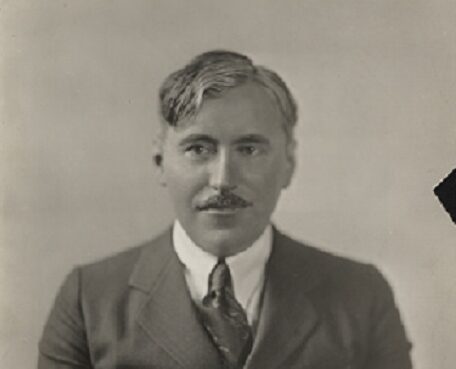Mack Sennett (January 17, 1880 – November 5, 1960) was a Canadian-born American director and actor and was known as the innovator of slapstick comedy in film and often coined the “King of Comedy.” His anarchic world of cross-eyed rubes, bearded villains, fetching bathing beauties, and custard pie throwing was an unexpected creation of a man who grew up wanting to be an opera star. Sennett’s brand of crude slapstick humor proved to be highly popular with audiences and helped him become one of the most powerful men of early Hollywood.
Sennett founded Keystone Studios in 1912 and comedies were cranked out at production-line speed, with several produced in one day from an outline prepared under Sennett’s supervision. He instituted a strict formula for his movies despite the appearance of a frenzied freedom onscreen, forgoing characterization in favor of stereotypes for audiences to make an immediate identification and issued strict rules governing the type of gags that could be used, with manic car chases and pie tossing becoming comic staples. Many important actors cemented their film careers with Sennett, including Marie Dressler, Mabel Normand, Charles Chaplin, Roscoe Arbuckle, Harold Lloyd, Raymond Griffith, Gloria Swanson, Ford Sterling, Andy Clyde, Chester Conklin, Polly Moran, Bing Crosby and W. C. Fields.
In 1917 Sennett gave up the Keystone trademark and organized his own company, Mack Sennett Comedies Corporation. Sennett went on to produce more ambitious comedy short films and a few feature-length films. During the 1920s his short subjects were in much demand, with stars like Billy Bevan, Ben Turpin, Mabel Normand, Charlie Murray, and Harry Langdon.
In the mid-1920s, Sennett chose to begin distributing his pictures through Pathé, which seemed like a shrewd move given the large amount of theaters they distributed to. But when Paramount and MGM began carving away at their market share, Pathé lost a large number of exhibitors and led to hard times for Sennett.
By the end of the 1920s, he adapted to accommodate the advent of sound pictures making a rather effortless transition and even making occasional forays into experimenting with color. But despite his embrace of new technology, Sennett stubbornly clung to outmoded storytelling techniques. Meanwhile, he partnered with Paramount Pictures, only to find the relationship last for a year. Unable to pull himself up during the Great Depression, he directed Buster Keaton in one of his last films, “The Timid Young Man” (1935), before lapsing into semi-retirement. He received an honorary Oscar in 1938. His Keystone Kops re-emerged in “Abbott and Costello Meet the Keystone Kops” (1955), only to once again slip into obscurity. Five years later, Sennett died in 1960 in Woodland Hills, CA at 80 years old.



